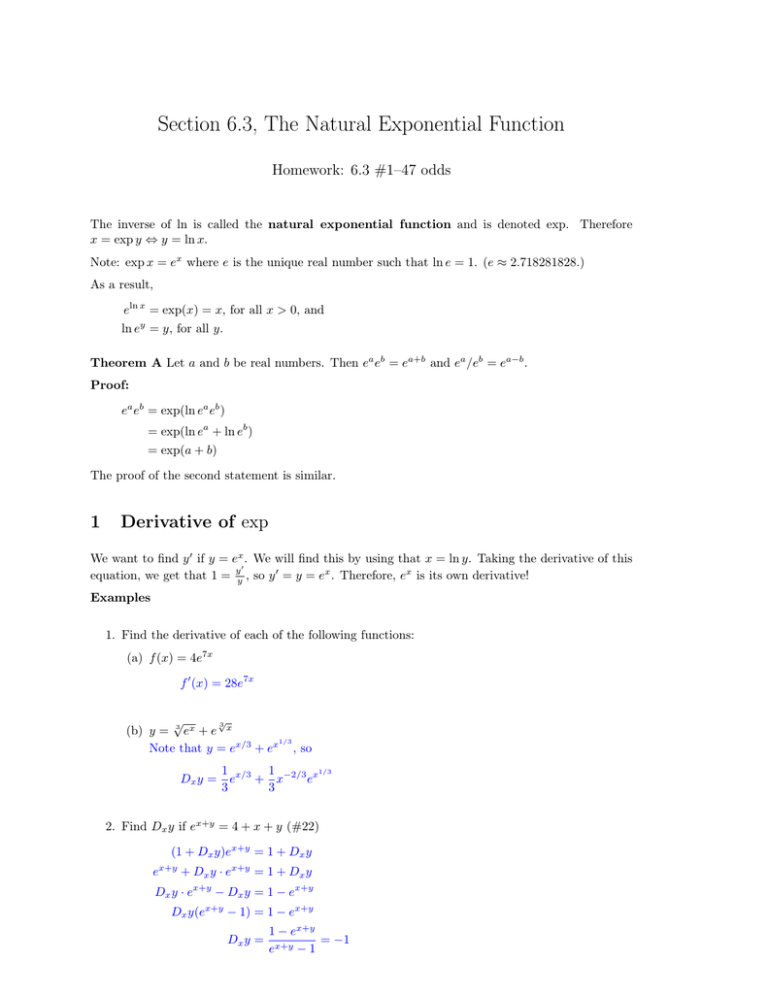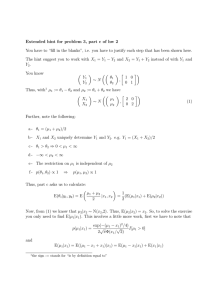Section 6.3, The Natural Exponential Function Homework: 6.3 #1–47 odds
advertisement

Section 6.3, The Natural Exponential Function Homework: 6.3 #1–47 odds The inverse of ln is called the natural exponential function and is denoted exp. Therefore x = exp y ⇔ y = ln x. Note: exp x = ex where e is the unique real number such that ln e = 1. (e ≈ 2.718281828.) As a result, eln x = exp(x) = x, for all x > 0, and ln ey = y, for all y. Theorem A Let a and b be real numbers. Then ea eb = ea+b and ea /eb = ea−b . Proof: ea eb = exp(ln ea eb ) = exp(ln ea + ln eb ) = exp(a + b) The proof of the second statement is similar. 1 Derivative of exp We want to find y 0 if y = ex . We will find this by using that x = ln y. Taking the derivative of this 0 equation, we get that 1 = yy , so y 0 = y = ex . Therefore, ex is its own derivative! Examples 1. Find the derivative of each of the following functions: (a) f (x) = 4e7x f 0 (x) = 28e7x √ √ 3 (b) y = 3 ex + e x 1/3 Note that y = ex/3 + ex , so Dx y = 1 x/3 1 −2/3 x1/3 e + x e 3 3 2. Find Dx y if ex+y = 4 + x + y (#22) (1 + Dx y)ex+y = 1 + Dx y ex+y + Dx y · ex+y = 1 + Dx y Dx y · ex+y − Dx y = 1 − ex+y Dx y(ex+y − 1) = 1 − ex+y Dx y = 1 − ex+y = −1 ex+y − 1 Rx 3. Find the domain and range of f (x) = 0 te−t dt and then find where it is increasing and decreasing. Also find where it is concave upward and downward, as well as all extreme values and points of inflection. Then sketch the graph. (#36) The domain is all real numbers, since te−t (and also the definite integral) is always defined. The range is [0, ∞). Note that f 0 (x) = xe−x , so f 0 (x) = 0 at x = 0. The function is decreasing for x < 0 and increasing for x > 0. There is a minimum point at (0, 0). f 00 (x) = e−x −xe−x = (1−x)e−x , so f 00 (x) = 0 at x = 1. Therefore, the graph is concave up on (−∞, 1) and concave down on (1, ∞). There is a point of inflection at (1, 1−2e−1 ) = (1, .26424) (We will learn how to find the y-value in Chapter 7.). (Graph done in class) 2 Integral of exp Z eu du = eu + C Examples 1. Calculate each of the following integrals: R (a) e2x+4 dx Z (b) e2x+4 +C 2 2 e4/x /x3 Let u = 4/x2 = 4x−2 . Then, du = −8x−3 dx, so R Z (c) e2x+4 dx = R e2t e2t +1 Z 2 2 e4/x e4/x =− + C. 3 x 8 dt e2t 1 dt = ln(e2t + 1) + C 2t e +1 2 (Note that the absolute value symbols are not necessary since e2t + 1 > 0) 2 2. The region bounded by y = e−x , y = 0, x = 0, and x = 1 is revolved about the y-axis. Find the volume of the resulting solid. (#46) Using the “Method of Shells” we see that 1 Z b Z 1 −x2 −x2 −1 −1 V = 2π xf (x) dx = 2π xe = −πe = −π(e − 1) = π(1 − e ). a 0 0



